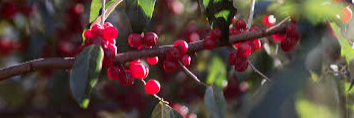Here we are again with another wild edibles blog post! Berries seem to emerge as the theme beyond the summertime. Though I considered writing about Stinkhorn Mushrooms in the spirit of Halloween and changing it up, Autumn Olives are calling out.

Autumn Olives look like bountiful, bunches of small red grapes that hang heavy on its branches. Before the berries ripen, they are silvery red and speckled. The stems also carry this silver speckled appearance, and can have some small thorns. Before the berries form, Autumn Olive develops into clusters of yellow flowers. Its leaves are narrow and canoe shaped, with a medium green on the outside and a silvery hue on the under-layer–much like the color scheme of another controversial medicinal, mugwort.

Though elaeagnus umbellata is called Autumn Olive, it is actually a shrub, and its olives are berries. Another name for Autumn Olive is Japanese Silverberry. It originates from East Asia and was originally planted in North America for use as an ornamental and in erosion control, and is since considered an invasive species here because it outcompetes native plants with its abundant seeds, attractiveness to a bird’s diet, and nitrogen fixing roots. As a nitrogen fixer, it can grow in all kinds of soils and conditions, and returns nutrients to the soil for its seedlings.

Because it is considered invasive and can proliferate so quickly–casting up to 200,000 seeds per year–harvesting and using its berries in larger quantities is encouraged (though remember to be kind and gentle while harvesting, and leaving some for the birds and for the elaeagnus umbellata themselves!). You can carefully clip off a bunch of berries in one go, like a bunch of grapes. You can also go down the small branches the berries hang from and pull many off at once.

The Autumn Olive berries are quite sour and tart, with a big seed inside. There is a slight tannin-like, astringent experience in eating them raw, and this often goes away by cooking them into a jam or a pie. Raw or cooked, they offer antioxidants. I would like to make a jam with frozen Serviceberries from the Spring and Autumn Olives from the Fall to mellow it’s tartness with Serviceberry’s savoryness. Check out some recipes for Autumn Olives below:
Go out and look for Autumn Olives, and let us know if you find them by tagging us in a picture on instagram @marylandnature. Happy Foraging!

